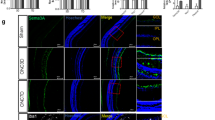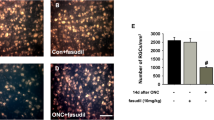Abstract
To examine the expression of P53-induced protein with a death domain (PIDD) at retina in animal model of optic nerve crush (ONC) and to investigate the role of PIDD in retinal glial activation and NF-κB activation induced by optic nerve damage, ONC animal model was established in Sprague–Dawley rats. PIDD has three isoforms (Isof); Western blot was performed to examine the expression of PIDD (Isof-1, Isof-2, and Isof-3, respectively) in retina at different time points after ONC. Retinal glial activation is closely associated with retinal neuronal death and is monitored by the expression of GFAP+ glial cells and IBA1+ microglia, then activated microglia leads to inflammatory cytokine production. NF-kB activation in glial cells also can promote neuronal death. In our study, the role of PIDD in retinal glial activation and NF-kB activation was investigated with PIDD inhibition selectively. PIDD expression (Isof-1 and Isof-3) was dramatically increased, and peaked at 3 days after ONC, while Isof-2 did not show any difference. In the ONC animal model, the number of GFAP+ glial cells and IBA1+ microglia in retinal layers was increased significantly, inflammatory cytokine production was upregulated, and NF-κB in glial cell was also activated. Moreover, those responses induced by optic nerve damage were attenuated with PIDD inhibition, which indicated that PIDD could regulate retinal glial activation, neuro-inflammation, and NF-κB activation. These results provided the direct demonstration that the PIDD (Isof-1and Isof-3) was overexpressed in retina after ONC, and PIDD may be involved in retinal neurodegenerative diseases by regulating retinal glial activation and NF-κB activation.




Similar content being viewed by others
References
Anderson CM, Swanson RA (2000) Astrocyte glutamate transport: review of properties, regulation, and physiological functions. Glia 32(1):1–14
Arranz-Romera A, Esteban-Perez S, Garcia-Herranz D, Aragon-Navas A, Bravo-Osuna I et al (2019) Combination therapy and co-delivery strategies to optimize treatment of posterior segment neurodegenerative diseases. Drug Discov Today 24(8):1644–1653
Bagli E, Zikou AK, Agnantis N, Kitsos G (2017) Mitochondrial membrane dynamics and inherited optic neuropathies. Vivo 31(4):511–525
Bock FJ, Peintner L, Tanzer M, Manzl C, Villunger A (2012) P53-induced protein with a death domain (PIDD): master of puppets? Oncogene 31(45):4733–4739
Bosco A, Steele MR, Vetter ML (2011) Early microglia activation in a mouse model of chronic glaucoma. J Comp Neurol 519(4):599–620
Carmignoto G (2000) Reciprocal communication systems between astrocytes and neurones. Prog Neurobiol 62(6):561–581
Cazareth J, Guyon A, Heurteaux C, Chabry J, Petit-Paitel A (2014) Molecular and cellular neuroinflammatory status of mouse brain after systemic lipopolysaccharide challenge: importance of CCR2/CCL2 signaling. J Neuroinflammation 11:132
Chen M, Xu H (2015) Parainflammation, chronic inflammation, and age-related macular degeneration. J Leukoc Biol 98(5):713–725
Ching S, Zhang H, Belevych N, He L, Lai W et al (2007) Endothelial-specific knockdown of interleukin-1 (IL-1) type 1 receptor differentially alters CNS responses to IL-1 depending on its route of administration. J Neurosci 27(39):10476–10486
Chong RS, Martin KR (2015) Glial cell interactions and glaucoma. Curr Opin Ophthalmol 26(2):73–77
Crumrine RC, Thomas AL, Morgan PF (1994) Attenuation of p53 expression protects against focal ischemic damage in transgenic mice. J Cereb Blood Flow Metab 14(6):887–891
Cuenca N, Fernandez-Sanchez L, Campello L, Maneu V, De la Villa P et al (2014) Cellular responses following retinal injuries and therapeutic approaches for neurodegenerative diseases. Prog Retin Eye Res 43:17–75
Cuenin S, Tinel A, Janssens S, Tschopp J (2008) p53-induced protein with a death domain (PIDD) isoforms differentially activate nuclear factor-kappaB and caspase-2 in response to genotoxic stress. Oncogene 27(3):387–396
Dantzer R, O'Connor JC, Freund GG, Johnson RW, Kelley KW (2008) From inflammation to sickness and depression: when the immune system subjugates the brain. Nat Rev Neurosci 9(1):46–56
DiDonato JA, Mercurio F, Karin M (2012) NF-kappaB and the link between inflammation and cancer. Immunol Rev 246(1):379–400
Fenn AM, Hall JC, Gensel JC, Popovich PG, Godbout JP (2014) IL-4 signaling drives a unique arginase+/IL-1beta+ microglia phenotype and recruits macrophages to the inflammatory CNS: consequences of age-related deficits in IL-4Ralpha after traumatic spinal cord injury. J Neurosci 34(26):8904–8917
Garcia M, Vecino E (2003) Role of Muller glia in neuroprotection and regeneration in the retina. Histol Histopathol 18(4):1205–1218
Hamel CP (2013) Inherited retinal dystrophies: contributions of molecular genetics. Biol Aujourdhui 207(2):73–85
Huang L, Han D, Yang X, Qin B, Ji G et al (2011) PIDD4, a novel PIDD isoform without the LRR domain, can independently induce cell apoptosis in cytoplasm. Biochem Biophys Res Commun 407(1):86–91
Inman DM, Horner PJ (2007) Reactive nonproliferative gliosis predominates in a chronic mouse model of glaucoma. Glia 55(9):942–953
Janssens S, Tinel A (2012) The PIDDosome, DNA-damage-induced apoptosis and beyond. Cell Death Differ 19(1):13–20
Janssens S, Tschopp J (2006) Signals from within: the DNA-damage-induced NF-kappaB response. Cell Death Differ 13(5):773–784
Janssens S, Tinel A, Lippens S, Tschopp J (2005) PIDD mediates NF-kappaB activation in response to DNA damage. Cell 123(6):1079–1092
Joo CK, Choi JS, Ko HW, Park KY, Sohn S et al (1999) Necrosis and apoptosis after retinal ischemia: involvement of NMDA-mediated excitotoxicity and p53. Invest Ophthalmol Vis Sci 40(3):713–720
Lin Y, Ma W, Benchimol S (2000) Pidd, a new death-domain-containing protein, is induced by p53 and promotes apoptosis. Nat Genet 26(1):122–127
Mac Nair CE, Schlamp CL, Montgomery AD, Shestopalov VI, Nickells RW (2016) Retinal glial responses to optic nerve crush are attenuated in Bax-deficient mice and modulated by purinergic signaling pathways. J Neuroinflammation 13(1):93
Mancino R, Martucci A, Cesareo M, Giannini C, Corasaniti MT et al (2018) Glaucoma and alzheimer disease: one age-related neurodegenerative disease of the brain. Curr Neuropharmacol 16(7):971–977
Minghetti L (2005) Role of inflammation in neurodegenerative diseases. Curr Opin Neurol 18(3):315–321
Morrison RS, Wenzel HJ, Kinoshita Y, Robbins CA, Donehower LA et al (1996) Loss of the p53 tumor suppressor gene protects neurons from kainate-induced cell death. J Neurosci 16(4):1337–1345
Nakatake S, Murakami Y, Ikeda Y, Morioka N, Tachibana T et al (2016) MUTYH promotes oxidative microglial activation and inherited retinal degeneration. JCI Insight 1(15):e87781
Newman EA, Zahs KR (1998) Modulation of neuronal activity by glial cells in the retina. J Neurosci 18(11):4022–4028
Pick R, Badura S, Bosser S, Zornig M (2006) Upon intracellular processing, the C-terminal death domain-containing fragment of the p53-inducible PIDD/LRDD protein translocates to the nucleoli and interacts with nucleolin. Biochem Biophys Res Commun 349(4):1329–1338
Ramirez AI, Salazar JJ, de Hoz R, Rojas B, Gallego BI et al (2015) Macro- and microglial responses in the fellow eyes contralateral to glaucomatous eyes. Prog Brain Res 220:155–172
Rapino C, Tortolani D, Scipioni L, Maccarrone M (2018) Neuroprotection by (endo)Cannabinoids in Glaucoma and Retinal Neurodegenerative Diseases. Curr Neuropharmacol 16(7):959–970
Spaide RF (2016) Retinal vascular cystoid macular edema: Review and New Theory. Retina 36(10):1823–1842
Tang Z, Zhang S, Lee C, Kumar A, Arjunan P et al (2011) An optic nerve crush injury murine model to study retinal ganglion cell survival. J Vis Exp 50:2685
Tanihara H, Hangai M, Sawaguchi S, Abe H, Kageyama M et al (1997) Up-regulation of glial fibrillary acidic protein in the retina of primate eyes with experimental glaucoma. Arch Ophthalmol 115(6):752–756
Telegina DV, Kozhevnikova OS, Kolosova NG (2018) Changes in retinal glial cells with age and during development of age-related macular degeneration. Biochemistry (Mosc) 83(9):1009–1017
Telliez JB, Bean KM, Lin LL (2000) LRDD, a novel leucine rich repeat and death domain containing protein. Biochim Biophys Acta 1478(2):280–288
Tezel G (2006) Oxidative stress in glaucomatous neurodegeneration: mechanisms and consequences. Prog Retin Eye Res 25(5):490–513
Tezel G, Wax MB (2003) Glial modulation of retinal ganglion cell death in glaucoma. J Glaucoma 12(1):63–68
Tezel G, Li LY, Patil RV, Wax MB (2001) TNF-alpha and TNF-alpha receptor-1 in the retina of normal and glaucomatous eyes. Invest Ophthalmol Vis Sci 42(8):1787–1794
Tian K, Shibata-Germanos S, Pahlitzsch M, Cordeiro MF (2015) Current perspective of neuroprotection and glaucoma. Clin Ophthalmol 9:2109–2118
Torriglia A, Jaadane I, Lebon C (2016) Mechanisms of cell death in neurodegenerative and retinal diseases: common pathway? Curr Opin Neurol 29(1):55–60
Tsacopoulos M, Poitry-Yamate CL, Poitry S, Perrottet P, Veuthey AL (1997) The nutritive function of glia is regulated by signals released by neurons. Glia 21(1):84–91
Wang L, Cioffi GA, Cull G, Dong J, Fortune B (2002) Immunohistologic evidence for retinal glial cell changes in human glaucoma. Invest Ophthalmol Vis Sci 43(4):1088–1094
Watanabe T, Raff MC (1988) Retinal astrocytes are immigrants from the optic nerve. Nature 332(6167):834–837
Wilson GN, Inman DM, Dengler Crish CM, Smith MA, Crish SD (2015) Early pro-inflammatory cytokine elevations in the DBA/2J mouse model of glaucoma. J Neuroinflammation 12:176
Xu Y, Yu S, Shu Q, Yang L, Yang C et al (2014) Upregulation of CREM-1 relates to retinal ganglion cells apoptosis after light-induced damage in vivo. J Mol Neurosci 52(3):331–338
Yuan L, Neufeld AH (2001) Activated microglia in the human glaucomatous optic nerve head. J Neurosci Res 64(5):523–532
Acknowledgements
This study was supported by the National Natural Science Foundation of China (Grant Nos. 81560166, 81760178, 81760172, 81460087, and 81660168), the Natural Science Foundation of Guangxi Zhuang Autonomous Region (Grant Nos. 2018GXNSFAA281128 and 2018GXNSFBA050057), Key Technologies & Program of Guangxi (Grant No.1598012-17), and China Postdoctoral Science Foundation (Grant No. 2019M663413)
Author information
Authors and Affiliations
Corresponding authors
Ethics declarations
Conflict of interest
The authors declare that they have no conflicts of interest.
Additional information
Publisher's Note
Springer Nature remains neutral with regard to jurisdictional claims in published maps and institutional affiliations.
Rights and permissions
About this article
Cite this article
Tang, F., Xu, F., Cui, L. et al. The expression and role of PIDD in retina after optic nerve crush. J Mol Hist 51, 89–97 (2020). https://doi.org/10.1007/s10735-020-09860-1
Received:
Accepted:
Published:
Issue Date:
DOI: https://doi.org/10.1007/s10735-020-09860-1




